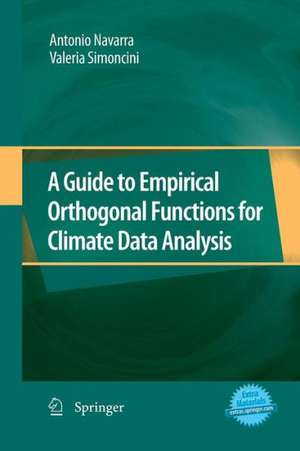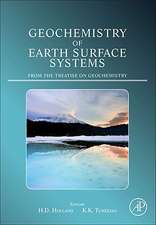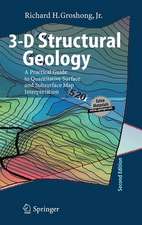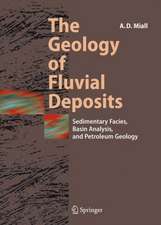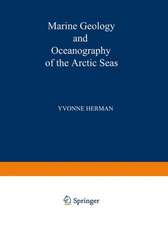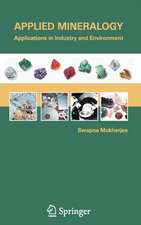A Guide to Empirical Orthogonal Functions for Climate Data Analysis
Autor Antonio Navarra, Valeria Simoncinien Limba Engleză Paperback – 23 noi 2014
A Guide to Empirical Orthogonal Functions for Climate Data Analysis uses a different approach, trying to introduce the reader to a practical application of the methods, including data sets from climate simulations and MATLAB codes for the algorithms. All pictures and examples used in the book may be reproduced by using the data sets and the routines available in the book .
Though the main thrust of the book is for climatological examples, the treatment is sufficiently general that the discussion is also useful for students and practitioners in other fields.
Supplementary datasets are available via http://extra.springer.com
| Toate formatele și edițiile | Preț | Express |
|---|---|---|
| Paperback (1) | 571.99 lei 38-44 zile | |
| SPRINGER NETHERLANDS – 23 noi 2014 | 571.99 lei 38-44 zile | |
| Hardback (1) | 697.15 lei 6-8 săpt. | |
| SPRINGER NETHERLANDS – 26 feb 2010 | 697.15 lei 6-8 săpt. |
Preț: 571.99 lei
Preț vechi: 752.61 lei
-24% Nou
Puncte Express: 858
Preț estimativ în valută:
109.46€ • 118.86$ • 91.95£
109.46€ • 118.86$ • 91.95£
Carte tipărită la comandă
Livrare economică 18-24 aprilie
Preluare comenzi: 021 569.72.76
Specificații
ISBN-13: 9789400791602
ISBN-10: 9400791607
Pagini: 160
Ilustrații: VI, 151 p.
Dimensiuni: 155 x 235 x 8 mm
Greutate: 0.23 kg
Ediția:2010
Editura: SPRINGER NETHERLANDS
Colecția Springer
Locul publicării:Dordrecht, Netherlands
ISBN-10: 9400791607
Pagini: 160
Ilustrații: VI, 151 p.
Dimensiuni: 155 x 235 x 8 mm
Greutate: 0.23 kg
Ediția:2010
Editura: SPRINGER NETHERLANDS
Colecția Springer
Locul publicării:Dordrecht, Netherlands
Public țintă
Professional/practitionerCuprins
Elements of Linear Algebra.- Basic Statistical Concepts.- Empirical Orthogonal Functions.- Generalizations: Rotated, Complex, Extended and Combined EOF.- Cross-Covariance and the Singular Value Decomposition.- The Canonical Correlation Analysis.- Multiple Linear Regression Methods.
Textul de pe ultima copertă
Climatology and meteorology have basically been a descriptive science until it became possible to use numerical models, but it is crucial to the success of the strategy that the model must be a good representation of the real climate system of the Earth. Models are required to reproduce not only the mean properties of climate, but also its variability and the strong spatial relations between climate variability in geographically diverse regions. Quantitative techniques were developed to explore the climate variability and its relations between different geographical locations. Methods were borrowed from descriptive statistics, where they were developed to analyze variance of related observations-variable pairs, or to identify unknown relations between variables.
A Guide to Empirical Orthogonal Functions for Climate Data Analysis uses a different approach, trying to introduce the reader to a practical application of the methods, including data sets from climate simulations and MATLAB codes for the algorithms. All pictures and examples used in the book may be reproduced by using the data sets and the routines available in the book .
Though the main thrust of the book is for climatological examples, the treatment is sufficiently general that the discussion is also useful for students and practitioners in other fields.
A Guide to Empirical Orthogonal Functions for Climate Data Analysis uses a different approach, trying to introduce the reader to a practical application of the methods, including data sets from climate simulations and MATLAB codes for the algorithms. All pictures and examples used in the book may be reproduced by using the data sets and the routines available in the book .
Though the main thrust of the book is for climatological examples, the treatment is sufficiently general that the discussion is also useful for students and practitioners in other fields.
Caracteristici
Availability of source codes for the pictures Step-by-step introduction to the methods and implementation Practical application of methods as encountered in real problems Mathematical base largely self-included Includes supplementary material: sn.pub/extras
